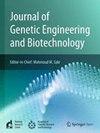What’s in (y)our food? − Occurrence of GM-containing foods on the Nigerian market and compliance with national regulations
IF 2.8
Q3 Biochemistry, Genetics and Molecular Biology
Journal of Genetic Engineering and Biotechnology
Pub Date : 2025-03-26
DOI:10.1016/j.jgeb.2025.100481
引用次数: 0
Abstract
The regulation of genetically modified (GM) food products in several jurisdictions considers appropriate labelling to be a key requirement for food safety and to ensure the protection of consumer choices. In Nigeria, such regulations are enforced by relevant government agencies. There is, however, little information on compliance levels with appropriate labeling regimes of GM products in Nigeria. This study was conducted to ascertain compliance with existing labeling guidelines and regulations for GM food products sampled from Abuja, Nigeria. DNA-based real-time polymerase chain reaction detection procedures were used to evaluate 15 processed and semi-processed pre-packaged food products obtained from retail stores in Abuja for the presence of specific regulatory sequences specific to GM products. Three regions present in GM food products were targeted, namely, the 35S promoter gene from cauliflower mosaic virus and figwort mosaic virus, with the nopaline synthase terminator from Agrobacterium tumefaciens. Eleven out of the 15 samples showed positive amplification for at least one regulatory sequence signature unique to GMOs, out of which only two were appropriately labeled as required by regulation. While the safety of GM products is a prerequisite for commercialization, labelling is required to protect consumer preference. The roles of relevant government agencies in developing appropriate labeling guidelines and enforcing the same to protect consumers’ choices are discussed.
我们的食物里有什么?−尼日利亚市场上是否出现转基因食品,是否符合国家法规
一些司法管辖区对转基因食品的监管认为,适当的标签是食品安全和确保保护消费者选择的一项关键要求。在尼日利亚,此类规定由相关政府机构执行。然而,关于尼日利亚对转基因产品适当标签制度遵守程度的信息很少。进行这项研究是为了确定从尼日利亚阿布贾取样的转基因食品是否遵守现有的标签准则和法规。采用基于dna的实时聚合酶链反应检测程序,对从阿布贾零售商店获得的15种加工和半加工预包装食品进行了转基因产品特异性调控序列的评估。转基因食品中存在的三个区域,即花菜花叶病毒和无花果花叶病毒的35S启动子基因,以及农杆菌的诺帕碱合成酶终止子。15个样品中有11个对转基因生物特有的至少一个调控序列特征表现出阳性扩增,其中只有两个被适当地标记为法规要求。虽然转基因产品的安全性是商业化的先决条件,但为保护消费者的偏好,需要对其进行标签。讨论了有关政府机构在制定适当的标签准则和执行这些准则以保护消费者选择方面的作用。
本文章由计算机程序翻译,如有差异,请以英文原文为准。
求助全文
约1分钟内获得全文
求助全文
来源期刊

Journal of Genetic Engineering and Biotechnology
Biochemistry, Genetics and Molecular Biology-Biotechnology
CiteScore
5.70
自引率
5.70%
发文量
159
审稿时长
16 weeks
期刊介绍:
Journal of genetic engineering and biotechnology is devoted to rapid publication of full-length research papers that leads to significant contribution in advancing knowledge in genetic engineering and biotechnology and provide novel perspectives in this research area. JGEB includes all major themes related to genetic engineering and recombinant DNA. The area of interest of JGEB includes but not restricted to: •Plant genetics •Animal genetics •Bacterial enzymes •Agricultural Biotechnology, •Biochemistry, •Biophysics, •Bioinformatics, •Environmental Biotechnology, •Industrial Biotechnology, •Microbial biotechnology, •Medical Biotechnology, •Bioenergy, Biosafety, •Biosecurity, •Bioethics, •GMOS, •Genomic, •Proteomic JGEB accepts
 求助内容:
求助内容: 应助结果提醒方式:
应助结果提醒方式:


